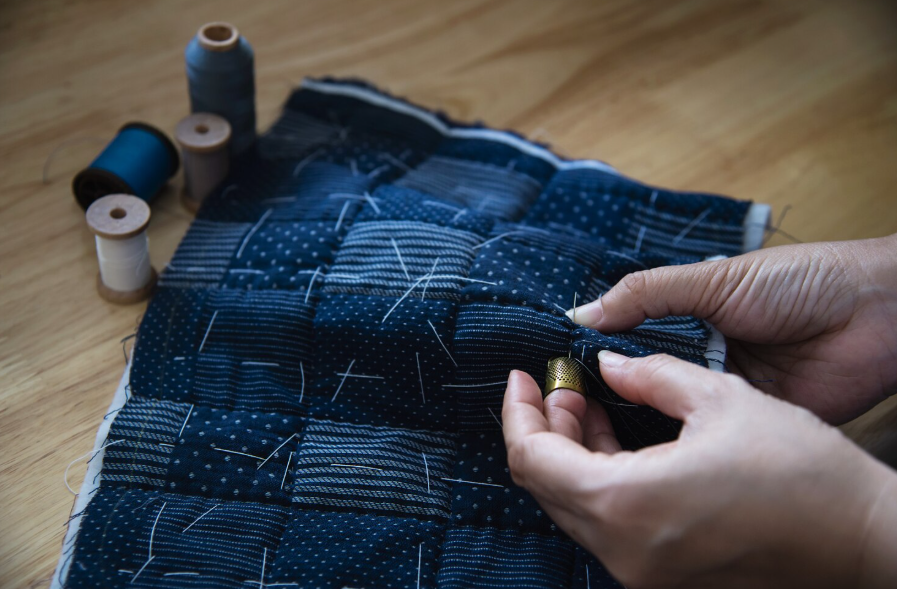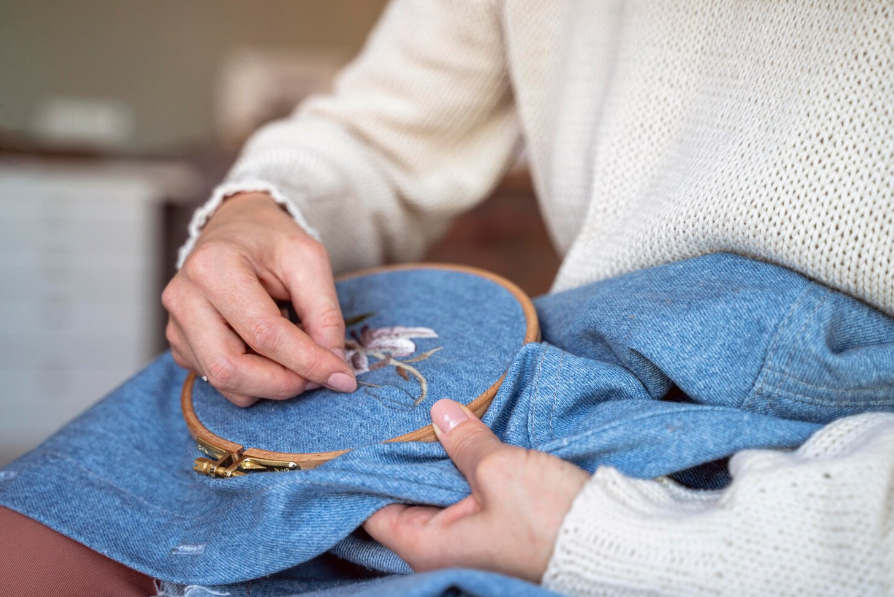Blog
Nahttypen im Überblick: Die wichtigsten Nähte und ihre Einsatzbereiche

Stitches, also called “Nahttypen” in German, are one of the most essential elements in sewing and textile construction. They hold fabric pieces together, provide structure, and even enhance the design of clothing and other textile products. While most people associate stitches only with repairing torn clothes, they play a far more significant role in the fashion and textile industry. Understanding stitch types is essential for designers, tailors, and hobby sewers alike.
Importance of Stitch Types
The type of stitch chosen for a garment or textile project influences not only its durability but also its flexibility, appearance, and overall comfort. Some stitches are designed to be invisible and purely functional, while others serve decorative purposes. Choosing the wrong stitch can weaken the garment and make it less wearable, while the right stitch adds both strength and beauty.
Hand Stitches
Hand stitches are among the oldest sewing methods. Before sewing machines were invented, all garments were made using hand stitching techniques. These stitches are still used today in tailoring, embroidery, and delicate sewing tasks. Hand stitches provide control and precision that machines cannot always replicate.
Running Stitch
The running stitch is one of the simplest and most versatile stitches. It consists of straight, evenly spaced stitches that move in and out of the fabric. It is commonly used for temporary basting, gathering fabric, or even decorative purposes. Despite its simplicity, this stitch can be very effective.
Backstitch
The backstitch is stronger than the running stitch and is often used for seams that require durability. It involves stitching backward on the fabric to secure each step, creating a continuous line without gaps. This stitch is widely used in embroidery as well as garment construction.
Slip Stitch
The slip stitch, also known as the invisible stitch, is often used for hemming and closing seams in a way that hides the thread. It is popular in professional tailoring because it allows garments to look clean and finished without visible stitching on the outside.
Overcast Stitch
The overcast stitch prevents fabric edges from fraying. It wraps the thread around the edge of the fabric, reinforcing it against wear and tear. While sewing machines now perform this function through overlock or serger machines, the hand version is still useful for small projects and repairs.
Machine Stitches
With the invention of the sewing machine, stitching became faster, more efficient, and more consistent. Machine stitches dominate the textile industry today, providing everything from basic seams to complex decorative patterns.
Straight Stitch
The straight stitch is the most common machine stitch. It forms a simple line that can be adjusted in length and is used in nearly every type of sewing project. From dressmaking to upholstery, this stitch remains a foundation in sewing.
Zigzag Stitch
The zigzag stitch is versatile and useful for stretchy fabrics. Its back-and-forth motion allows the fabric to expand without breaking the thread. It is also used to prevent fraying on fabric edges and can serve decorative functions as well.
Overlock Stitch
The overlock stitch, often created by a serger machine, trims the fabric edge while wrapping the seam with thread. This professional finish is commonly found in store-bought clothing. It ensures durability and prevents unraveling, making it ideal for knitwear and casual garments.
Chain Stitch
The chain stitch creates a looped chain-like appearance. While decorative, it also provides elasticity, which is why it is often used in embroidery and certain industrial sewing. However, it can unravel quickly if the thread breaks, making it less durable for seams.
Blind Hem Stitch
The blind hem stitch is used when a hem should not be visible on the outside of the garment. The machine catches only a few threads of the fabric, leaving the stitch almost invisible. This is common in formal wear, curtains, and tailored clothing.
Decorative Stitches
Decorative stitches go beyond functionality, adding beauty and uniqueness to fabric. Both hand-sewn and machine-made decorative stitches are used in embroidery, quilting, and home décor. These stitches can turn plain fabrics into stunning works of art.
Cross Stitch
Cross stitch is a hand embroidery stitch that forms an “X” shape. It is used to create detailed patterns and designs on fabric. Often worked on counted fabric such as Aida cloth, cross stitch has become a popular hobby worldwide.
Satin Stitch
The satin stitch creates a smooth, filled area of embroidery by placing stitches closely side by side. It is commonly used for lettering, floral designs, and filling shapes. This stitch adds a luxurious and polished appearance to fabric.
Smocking Stitch
Smocking is both decorative and functional. It gathers fabric in a controlled way, allowing elasticity without needing elastic bands. Historically, smocking was used on cuffs and bodices, but today it also adds decorative interest to children’s clothing and dresses.
Blanket Stitch

The blanket stitch is often used for edging blankets, felt crafts, or appliqué. It creates a neat, looped border that not only prevents fraying but also adds a decorative outline. This stitch can be done by hand or machine.
Quilting Stitch
Quilting stitches are used to hold multiple layers of fabric and batting together. They can be simple running stitches or decorative patterns that add texture and beauty to quilts. The stitch pattern often enhances the overall design of the quilt.
Buttonhole Stitch
The buttonhole stitch reinforces the edges of buttonholes to prevent fraying. Modern machines can make buttonholes automatically, but hand-stitched buttonholes are still preferred in high-end tailoring because of their durability and elegance.
Embroidery Stitches
Embroidery stitches are designed to create artwork on fabric. They are not primarily functional but serve as decoration. Stitches like the French knot, stem stitch, and chain stitch all belong to this category, giving endless creative possibilities.
Choosing the Right Stitch
Selecting the right stitch depends on the type of fabric, purpose of the garment, and desired appearance. For example, stretchy fabrics require zigzag or overlock stitches, while delicate fabrics benefit from slip stitches. Decorative stitches can enhance visual appeal, but functional stitches provide strength. A good sewer often combines multiple stitch types in a single project for best results.
Conclusion
Understanding different stitch types, or “Nahttypen,” is key to mastering sewing skills. From the simplest running stitch to advanced embroidery techniques, each stitch has its purpose and value. Whether you are a professional tailor, fashion designer, or hobbyist, knowing when and how to use each stitch can elevate your work to a professional level. Sewing is not just about holding fabric together; it is about crafting with precision, creativity, and care.
FAQs
1. What is the strongest type of stitch?
The backstitch is considered one of the strongest hand stitches, while overlock stitches are very durable in machine sewing.
2. Which stitch is best for stretchy fabrics?
The zigzag stitch and overlock stitch are ideal for stretch fabrics because they allow flexibility without breaking.
3. Are hand stitches still used today?
Yes, hand stitches are still widely used in tailoring, embroidery, repairs, and delicate sewing work where machines cannot match precision.
4. What stitch is best for hemming?
The slip stitch or blind hem stitch is best for hemming, as they keep hems nearly invisible.
5. Can decorative stitches be functional too?
Yes, many decorative stitches like blanket stitches and smocking stitches also serve functional purposes, such as preventing fraying or adding elasticity.
-

 Tech1 year ago
Tech1 year agoHow to Use a Temporary Number for WhatsApp
-

 Business2 years ago
Business2 years agoSepatuindonesia.com | Best Online Store in Indonesia
-

 Social Media1 year ago
Social Media1 year agoThe Best Methods to Download TikTok Videos Using SnapTik
-

 Technology1 year ago
Technology1 year agoTop High Paying Affiliate Programs
-

 Tech10 months ago
Tech10 months agoUnderstanding thejavasea.me Leaks Aio-TLP: A Comprehensive Guide
-

 FOOD12 months ago
FOOD12 months agoHow to Identify Pure Desi Ghee? Ultimate Guidelines for Purchasing Authentic Ghee Online
-

 Instagram3 years ago
Instagram3 years agoFree Instagram Auto Follower Without Login
-

 Instagram3 years ago
Instagram3 years agoFree Instagram Follower Without Login



















